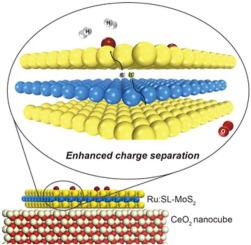当前位置:
X-MOL 学术
›
Mater. Today
›
论文详情
Our official English website, www.x-mol.net, welcomes your feedback! (Note: you will need to create a separate account there.)
2D photocatalysts with tuneable supports for enhanced photocatalytic water splitting
Materials Today ( IF 24.2 ) Pub Date : 2020-12-01 , DOI: 10.1016/j.mattod.2020.05.018 Yiyang Li , Simson Wu , Jianwei Zheng , Yung-Kang Peng , Dharmalingam Prabhakaran , Robert A. Taylor , Shik Chi Edman Tsang
Materials Today ( IF 24.2 ) Pub Date : 2020-12-01 , DOI: 10.1016/j.mattod.2020.05.018 Yiyang Li , Simson Wu , Jianwei Zheng , Yung-Kang Peng , Dharmalingam Prabhakaran , Robert A. Taylor , Shik Chi Edman Tsang

|
Abstract Sustainable hydrogen production is attracting increasing attention and visible-light-driven water splitting is considered as one of the most promising approaches for hydrogen evolution and solar energy storage. Different materials have been screened at mild conditions in recent decades and 2-dimensional (2D) layered materials are considered good candidates for the photocatalytic water splitting reaction. 2D single layer MoS2 has shown its potential in various catalytic systems, and has also been used in photocatalytic water splitting reaction recently. However, current studies of MoS2 monolayers give low intrinsic activity, preventing it from practical applications. This is attributed to the rapid recombination of the photo-excited charge carriers at room temperature, resulting in poor quantum efficiency (QE). Herein, a state-of-the-art strategy to prolong the exciton lifetimes is reported, which is achieved by combining the 2D MoS2 nanosheets with solid state polar-faceted supports. The charge separation process can be facilitated by the strong local polarisation introduced by the polar-faceted supports, and tuned by changing the supports with different surface polarities. Polar oxide surface is the exposure of oxygen-terminated high energetic facet, which is known to give a net dipole moment perpendicular to its surface. Such variation in the surface properties of the support to the above metal would lead to a difference in metal-support interaction(s). The resulting composite structures show great enhancement toward the visible-light-driven photocatalytic water splitting reaction, giving hydrogen and oxygen evolution in a stoichiometric 2:1 ratio at elevated temperatures from pure water. Photocatalytic performances are improved by the prolonged exciton lifetimes and exceptional hydrogen evolution activity of 2977 μmol g−1 h−1 with impressive QEs are obtained over Ru-doped MoS2 nanosheets on polar ceria support, which is among the best of the reported results of similar catalytic systems to date. More excitingly, the linear relationship between the exciton lifetimes and strength of the local polarisation is also observed, indicating that the rational design of photocatalysts can be simply achieved via engineering their local polarisation by incorporation of polar-faceted materials.
中文翻译:

具有可调节载体的二维光催化剂可增强光催化水分解
摘要 可持续制氢正引起越来越多的关注,可见光驱动的水分解被认为是最有前途的制氢和太阳能存储方法之一。近几十年来,已经在温和条件下筛选了不同的材料,二维 (2D) 层状材料被认为是光催化水分解反应的良好候选材料。二维单层二硫化钼在各种催化体系中显示出其潜力,最近也被用于光催化水分解反应。然而,目前对 MoS2 单层的研究给出了低内在活性,阻碍了它的实际应用。这归因于室温下光激发电荷载流子的快速复合,导致量子效率 (QE) 较差。在此处,报道了一种延长激子寿命的最新策略,这是通过将 2D MoS2 纳米片与固态极性面载体相结合来实现的。极性面载体引入的强局部极化可以促进电荷分离过程,并通过改变具有不同表面极性的载体进行调整。极性氧化物表面是氧终止的高能面的暴露,已知该面会产生垂直于其表面的净偶极矩。载体对上述金属的表面性质的这种变化将导致金属-载体相互作用的差异。由此产生的复合结构对可见光驱动的光催化分解水反应显示出极大的增强,以化学计量比 2 释放氢和氧:1 在升高温度下纯水的比例。通过延长激子寿命和 2977 μmol g−1 h−1 的特殊析氢活性提高光催化性能,在极性氧化铈载体上的 Ru 掺杂的 MoS2 纳米片上获得了令人印象深刻的 QE,这是同类报道中最好的结果之一。迄今为止的催化系统。更令人兴奋的是,还观察到激子寿命与局部极化强度之间的线性关系,表明光催化剂的合理设计可以通过引入极性面材料来设计局部极化来简单实现。通过延长激子寿命和 2977 μmol g−1 h−1 的特殊析氢活性提高光催化性能,在极性氧化铈载体上的 Ru 掺杂的 MoS2 纳米片上获得了令人印象深刻的 QE,这是同类报道中最好的结果之一。迄今为止的催化系统。更令人兴奋的是,还观察到激子寿命与局部极化强度之间的线性关系,表明光催化剂的合理设计可以通过引入极性面材料来设计局部极化来简单实现。通过延长激子寿命和 2977 μmol g−1 h−1 的特殊析氢活性提高光催化性能,在极性氧化铈载体上的 Ru 掺杂的 MoS2 纳米片上获得了令人印象深刻的 QE,这是同类报道中最好的结果之一。迄今为止的催化系统。更令人兴奋的是,还观察到激子寿命与局部极化强度之间的线性关系,表明光催化剂的合理设计可以通过引入极性面材料来设计局部极化来简单实现。
更新日期:2020-12-01
中文翻译:

具有可调节载体的二维光催化剂可增强光催化水分解
摘要 可持续制氢正引起越来越多的关注,可见光驱动的水分解被认为是最有前途的制氢和太阳能存储方法之一。近几十年来,已经在温和条件下筛选了不同的材料,二维 (2D) 层状材料被认为是光催化水分解反应的良好候选材料。二维单层二硫化钼在各种催化体系中显示出其潜力,最近也被用于光催化水分解反应。然而,目前对 MoS2 单层的研究给出了低内在活性,阻碍了它的实际应用。这归因于室温下光激发电荷载流子的快速复合,导致量子效率 (QE) 较差。在此处,报道了一种延长激子寿命的最新策略,这是通过将 2D MoS2 纳米片与固态极性面载体相结合来实现的。极性面载体引入的强局部极化可以促进电荷分离过程,并通过改变具有不同表面极性的载体进行调整。极性氧化物表面是氧终止的高能面的暴露,已知该面会产生垂直于其表面的净偶极矩。载体对上述金属的表面性质的这种变化将导致金属-载体相互作用的差异。由此产生的复合结构对可见光驱动的光催化分解水反应显示出极大的增强,以化学计量比 2 释放氢和氧:1 在升高温度下纯水的比例。通过延长激子寿命和 2977 μmol g−1 h−1 的特殊析氢活性提高光催化性能,在极性氧化铈载体上的 Ru 掺杂的 MoS2 纳米片上获得了令人印象深刻的 QE,这是同类报道中最好的结果之一。迄今为止的催化系统。更令人兴奋的是,还观察到激子寿命与局部极化强度之间的线性关系,表明光催化剂的合理设计可以通过引入极性面材料来设计局部极化来简单实现。通过延长激子寿命和 2977 μmol g−1 h−1 的特殊析氢活性提高光催化性能,在极性氧化铈载体上的 Ru 掺杂的 MoS2 纳米片上获得了令人印象深刻的 QE,这是同类报道中最好的结果之一。迄今为止的催化系统。更令人兴奋的是,还观察到激子寿命与局部极化强度之间的线性关系,表明光催化剂的合理设计可以通过引入极性面材料来设计局部极化来简单实现。通过延长激子寿命和 2977 μmol g−1 h−1 的特殊析氢活性提高光催化性能,在极性氧化铈载体上的 Ru 掺杂的 MoS2 纳米片上获得了令人印象深刻的 QE,这是同类报道中最好的结果之一。迄今为止的催化系统。更令人兴奋的是,还观察到激子寿命与局部极化强度之间的线性关系,表明光催化剂的合理设计可以通过引入极性面材料来设计局部极化来简单实现。



























 京公网安备 11010802027423号
京公网安备 11010802027423号